Research on the Sustainable Evolution Mechanism of Dual-Dimensional Convergence Innovation in Digital Products
Abstract
1. Introduction
- (1)
- Compared with traditional products, what are the fundamental characteristics of the innovation and evolutionary processes of digital products, and what innovation logic should be adopted?
- (2)
- What is the mechanism of innovation and evolution in digital products? How does the mechanism address the uncertainties of innovation? How does it solve the complexity challenges of digital products?
- (3)
- What new characteristics are possessed by the influencing factors of digital product innovation?
2. Literature Review
2.1. Types and Basic Characteristics of Digital Products and Digital Product Innovation
2.2. The Uncertainty and Innovation Logic of Digital Product Innovation
2.3. Knowledge Integration and Cognitive Translation in Digital Product Innovation
3. Research Methods
3.1. Research Object
3.1.1. Research Situation
3.1.2. Research Object
3.2. Data Collection
4. Case Analysis
4.1. Data Analysis Method
4.2. Evolution Characteristics of Digital Product Innovation
4.3. Evolution Process of Digital Product Innovation
4.3.1. Demand Perception
4.3.2. Scheme Formulation
- (1)
- Improvements in the plan based on the designer’s own cognition
- (2)
- Improvements in the plan based on the industry innovation database
4.3.3. Innovation Implementation
4.4. Influencing Factors of Digital Product Innovation and Evolution
4.4.1. Driving Factors
- (1)
- Customer needs
- (2)
- Market competition
- (3)
- Technical changes
- (4)
- Policy factors
4.4.2. Analysis of Supporting Factors
- (1)
- Enterprise external digital ecology
- (2)
- Enterprise’s own digital capability
5. Theory Aggregation and Model Construction
5.1. Dual-Dimensional Convergence Evolutionary Feature Model for Digital Product Innovation
5.2. The Digital Product Innovation Mechanism from the Perspective of the Evolution Theory
5.2.1. Three-Stage Process Model of Digital Product Innovation
5.2.2. The Proactive Selection Mechanism and Responses to Three Major Uncertainties in the Evolution of Digital Product Innovation
5.2.3. A Mechanism for Integration Knowledge through the Complementary Interplay between Cognitive and Social Translation in the Evolution of Digital Product Innovation
5.3. External Factors Affecting the Innovation and Evolution of Digital Products
5.3.1. Driving Factor
5.3.2. Supporting Factor
5.4. An Overall Model for the Evolution of Digital Products
5.4.1. Overall Model
5.4.2. Comparison of Traditional Product Innovation and Digital Product Innovation
6. Conclusions and Implications
6.1. Discussion
6.1.1. The Linear Perfection Logic of Traditional Innovation vs. The Dynamic Evolution and Adaptability Logic of Digital Product Innovation
6.1.2. Similarities and Differences between Digital Product Innovation Evolution Theory and Existing Related Theories
6.2. Research Conclusion and Theoretical Value
6.2.1. Characteristics of Digital Product Innovation Evolution and Adaptive Logic
6.2.2. The Process of Digital Product Innovation and Coping with Innovation Uncertainty
6.2.3. Drivers of Digital Product Innovation
6.3. Policy and Practical Implications
- Enhancing Market Adaptability and Strategic Agility: The proactive selection mechanism requires the management team to have keen market insights and strategic judgment. In the process of digital product innovation, firms need to continuously analyze market demands, competitive dynamics, and technological trends; quickly make strategic adjustments; and choose optimal innovation paths. The cognitive translation mechanism helps companies combine diverse external knowledge with internal experience, transforming it into actual innovation capability. Through these mechanisms, companies can enhance market adaptability and achieve agile strategic adjustments.
- Improving Resource Allocation Efficiency and Knowledge Integration Capability: The proactive selection mechanism allows firms to maximize the use of existing resources and external opportunities within limited resources, improving resource allocation efficiency. The cognitive translation mechanism effectively filters and transforms multi-source information, enabling the integration and application of knowledge from different sources within the company, forming a new knowledge system that continuously fuels innovation. These mechanisms enable firms to efficiently allocate R&D, human, and financial resources, thereby increasing innovation efficiency and success rates.
- Building Open Innovation Networks: Rapidly changing markets require companies to not only rely on internal R&D but also to actively absorb external knowledge and technology. The proactive selection mechanism allows firms to choose suitable external partners, while the cognitive translation mechanism helps them internalize this external knowledge into core competencies. Establishing open innovation networks can enhance the depth and breadth of knowledge sharing and technological cooperation, thereby accelerating the innovation process.
- Promoting Organizational Change and Cultural Shaping: To adapt to constantly changing market demands and technological trends, companies need to undergo corresponding changes in organizational structure and culture. The proactive selection mechanism emphasizes rapid decision making and flexible response, prompting companies to form a flat, flexible, and efficient organizational structure. The cognitive translation mechanism encourages cross-departmental and cross-field knowledge exchange and collaboration, fostering an open and inclusive culture of innovation. Through organizational change and cultural shaping, firms can enhance their innovative capacity and market competitiveness.
- Accelerating Technological Iteration and Product Optimization: In the digital product innovation process, the proactive selection mechanism enables firms to quickly select technological routes and market positions, thereby accelerating technological iteration. The cognitive translation mechanism helps companies merge internal technological accumulation with new external ideas and methods, continuously optimizing product features and user experience. Through these theoretical mechanisms, companies can rapidly respond to market changes and achieve continuous technological and product optimization and upgrades.
6.4. Further Research and Limitations
- The range and thresholds of uncertainties faced by enterprises engaged in digital product innovation may vary across different levels of economic development, industry types, and production scales.
- While it is posited in this paper that incremental and breakthrough innovations are two facets of the same coin, this does not account for the technical difficulty and associated risks of innovation, which are important aspects of innovation uncertainty.
- The specific context of the Chinese scenario in the case study may limit the generalizability of the findings. China, as a large developing country with rapid economic growth, well-developed digital infrastructure, and proactive digital industry policies, presents a context that differs significantly from other mature, developed economies.
Author Contributions
Funding
Institutional Review Board Statement
Informed Consent Statement
Data Availability Statement
Conflicts of Interest
References
- Usai, A.; Fiano, F.; Petruzzelli, A.M.; Paoloni, P.; Orlando, B. Unveiling the impact of the adoption of digital technologies on firms’ innovation performance. J. Bus. Res. 2021, 133, 327–336. [Google Scholar]
- Nylén, D.; Holmström, J. Digital innovation strategy: A framework for diagnosing and improving digital product and service innovation. Bus. Horiz. 2015, 58, 57–67. [Google Scholar]
- Chinese Academy of Social Sciences. Research Report on the Digital Service Capability Index of Financial Institutions; Chinese Academy of Social Sciences: Beijing, China, 2021. (In Chinese) [Google Scholar]
- iResearch. 2019 China Fintech Industry Research Report; iResearch: Shanghai, China, 2019. (In Chinese) [Google Scholar]
- Zhou, X. Information Technology Development and Financial Policy. Financ. Mark. Res. 2019, 88, 2–16. (In Chinese) [Google Scholar]
- Wind, J.; Mahajan, V. Issues and Opportunities in New Product Development: An Introduction to the Special Issue. J. Mark. Res. 1997, 34, 1–12. [Google Scholar]
- Christensen, C.M.; Raynor, M.; Mcdonald, R. What is Disruptive Innovation? Harv. Bus. Rev. 2015, 93, 44–53. [Google Scholar]
- Wu, Z.; Zhao, L. Cooperative Innovation or Independent Innovation? An Expanded AJ Model and It's used in the Internet Industry of China. Econ. Manag. 2011, 33, 141–149. (In Chinese) [Google Scholar]
- Forti, E.; Sobrero, M.; Vezzulli, A. Continuity, Change, and New Product Performance: The Role of Stream Concentration. J. Prod. Innov. Manag. 2020, 37, 228–248. [Google Scholar]
- Hippel, E.V.; von Krogh, G. Identifying Viable ‘Need–Solution Pairs’: Problem Solving Without Problem Formulation. Organ. Sci. 2016, 27, 207–221. [Google Scholar]
- Xiao, J.; Hu, Y.; Wu, Y. Evolving Product: A Case Study of Data-Driven Enterprise and User-Interactive Innovation. J. Manag. World 2020, 36, 183–205. (In Chinese) [Google Scholar]
- Feduzi, A.; Runde, J. Uncovering unknown unknowns: Towards a Baconian approach to management decision-making. Organ. Behav. Hum. Decis. Process. 2014, 124, 268–283. [Google Scholar]
- Lyytinen, K.; Yoo, Y.; Richard, J.; Boland, J. Digital product innovation within four classes of innovation networks. Inf. Syst. J. 2016, 26, 47–75. [Google Scholar]
- Nambisan; Satish; Lyytinen; Kalle; Majchrzak; Ann; Song; Michael. Digital Innovation Management: Reinventing Innovation Management Research In A Digital World. MIS Q. 2017, 41, 223–238. [Google Scholar]
- Sjödin, D.; Parida, V.; Kohtamäki, M.; Wincent, J. An agile co-creation process for digital servitization: A micro-service innovation approach. J. Bus. Res. 2020, 112, 478–491. [Google Scholar]
- Ries, E. The Lean Startup: How Today's Entrepreneurs Use Continuous Innovation to Create Radically Successful Businesses; Crown Business: New York, NY, USA, 2011. [Google Scholar]
- Brown, T. Change by Design: How Design Thinking Creates New Alternatives for Business and Society; Harper Business: New York, NY, USA, 2009. [Google Scholar]
- Chesbrough, H.W. The era of open innovation. MIT Sloan Manage. Rev. 2003, 44, 35–41. [Google Scholar]
- Davenport, T.H.; Harris, J.G. Competing on Analytics: The New Science of Winning; Harvard Business Review Press: Cambridge, MA, USA, 2007; Volume 15, pp. 59–61. [Google Scholar]
- Provost, F.; Fawcett, T. Data Science for Business: What You Need to Know about Data Mining and Data-Analytic Thinking; O'Reilly Media: Sebastopol, CA, USA, 2013. [Google Scholar]
- Beck, K.; Beedle, M.; Van Bennekum, A.; Cockburn, A.; Cunningham, W.; Fowler, M.; Kern, J. The Agile Manifesto. Available online: https://agilemanifesto.org/ (accessed on 30 June 2024).
- Christensen, C.M. The Innovator's Dilemma: When New Technologies Cause Great Firms to Fail; Harvard Business Press: Boston, MA, USA, 1997. [Google Scholar]
- Milliken, F.J. Three Types of Perceived Uncertainty About the Environment: State, Effect, and Response Uncertainty. Acad. Manag. Rev. 1987, 12, 133–143. [Google Scholar]
- Nonaka, I. A Dynamic Theory of Organizational Knowledge Creation. Organ. Sci. 1994, 5, 14–37. [Google Scholar]
- Grant, R.M. Toward a knowledge-based theory of the firm. Strateg. Manag. J. 1996, 17, 109–122. [Google Scholar]
- Alavi, M.; Leidner, D.E. Review: Knowledge Management and Knowledge Management Systems: Conceptual Foundations and Research Issues. MIS Q. 2001, 25, 107–136. [Google Scholar]
- Davenport, T.H.; Prusak, L. Working Knowledge: How Organizations Manage What They Know; Harvard Business Review Press: Cambridge, MA, USA, 1998. [Google Scholar]
- Zahra, S.A.; George, G. Absorptive Capacity: A Review, Reconceptualization and Extension. Acad. Manag. Rev. 2002, 27, 185–203. [Google Scholar]
- Argote, L.; Ingram, P.; Schaubroeck, J.M. Knowledge Transfer: A Basis for Competitive Advantage in Firms. Organ. Behav. Hum. Decis. Process. 2000, 82, 150–169. [Google Scholar]
- Edmondson, A. Psychological Safety and Learning Behavior in Work Teams. Adm. Sci. Q. 1999, 44, 350–383. [Google Scholar]
- Senge, P.M. The Fifth Discipline: The Art and Practice of the Learning Organization: Book Review; Doubleday/Currency: New York, NY, USA, 1991; Volume 30. [Google Scholar]
- Lave, J.; Wenger, E. Situated Learning: Legitimate Peripheral Participation; Cambridge University Press: Cambridge, UK, 1991. [Google Scholar]
- Galison, P. Image and Logic: A Material Culture of Microphysics; The University of Chicago Press: Chicago, IL, USA, 1997; Volume 50, p. 65. [Google Scholar]
- Tilson, D.; Lyytinen, K.; Srensen, C. Digital Infrastructures: The Missing IS Research Agenda. Inf. Syst. Res. 2010, 21, 748–759. [Google Scholar]
- Schumpeter, J.A. Capitalism, Socialism, and Democracy. Am. Econ. Rev. 1942, 3, 594–602. [Google Scholar]
- Fagerberg, J. Innovation: A Guide to the Literature; Oxford University Press: Oxford, UK, 2005; pp. 1–26. [Google Scholar]
- Porter, M.E. Competitive Strategy: Techniques for Analyzing Industries and Competitors. Soc. Sci. Electron. Publ. 1980, 2, 86–87. [Google Scholar]
- Teece, D.J. Dynamic capabilities and strategic management. Strateg. Manag. J. 1997, 18, 509–533. [Google Scholar]
- Porter, M.E. The Competitive Advantage of Nations. Compet. Intell. Rev. 1990, 1, 14. [Google Scholar]
- Mazzucato, M. The Entrepreneurial State. Soundings 2013, 49, 70–71. [Google Scholar]
- Hippel, E.V. Lead Users: An Important Source of Novel Product Concepts. Manage. Sci. 1986, 32, 773–907. [Google Scholar]
- Rindfleisch, A.; O'Hern, M.; Sachdev, V. The Digital Revolution, 3D Printing, and Innovation as Data. J. Prod. Innov. Manag. 2017, 34, 681–690. [Google Scholar]
- Boudreau, K.J. Let a Thousand Flowers Bloom? An Early Look at Large Numbers of Software App Developers and Patterns of Innovation. Organ. Sci. 2012, 23, 1409–1427. [Google Scholar]
- Xie, K.; Xiao, J.; Zhao, G. Economics of E-commerce; Publishing House of Electronics Industry: Beijing, China, 2003. [Google Scholar]
- Yu, J.; Meng, Q.; Zhang, Y.; Chen, F. Digital Innovation: Exploring and Inspiring New Perspectives in Innovation Research. Stud. Sci. Sci. 2017, 7, 1103–1111. [Google Scholar]
- Yoo, Y.; Boland, R.J.; Lyytinen, K.; Majchrzak, A. Organizing for Innovation in the Digitized World. Organ. Ence 2012, 23, 1398–1408. [Google Scholar]
- Drucker, P.F. Innovation and Entrepreneurship: Practice and Principles. Soc. Sci. Electron. Publ. 1985, 4, 85–86. [Google Scholar]
- Tian, H.; Grover, V.; Zhao, J.; Jiang, Y. The differential impact of types of app innovation on customer evaluation. Inf. Manag. 2020, 57, 103358. [Google Scholar]
- Foerderer, J.; Kude, T.; Mithas, S.; Heinzl, A. Does Platform Owner's Entry Crowd Out Innovation? Evidence from Google Photos. Inf. Syst. Res. 2018, 29, 444–460. [Google Scholar]
- Wen, W.; Zhu, F. Threat of platform-owner entry and complementor responses: Evidence from the mobile app market. Strateg. Manag. J. 2019, 40, 1336–1367. [Google Scholar]
- Randles, J. Research on the Uncertainty of Digital Product Innovation. Sci. Technol. Manag. Res. 2019, 37, 56–62. [Google Scholar]
- Fredberg, T. Creating and Capturing Value from External Knowledge: The Role of External Knowledge in Open Innovation in Pharmaceutical Development. Master’s Thesis, Chalmers University of Technology, Göteborg, Sweden, 2007. [Google Scholar]
- Tao, W.; Thomke, S.; Hippel, E.V. Lead User Projects: From Theory to Practice. J. Prod. Innov. Manag. 2010, 27, 666–677. [Google Scholar]
- Schweisfurth, T.G. Comparing internal and external lead users as sources of innovation. Res. Policy 2017, 46, 238–248. [Google Scholar]
- Lee, L. Leading User Innovation in the Digital Era. Res. Technol. Manag. 2018, 61, 26–35. [Google Scholar]
- Xiao, J.; Yao Wu, Y.L.; Xie, K. Consumer Date-driven Participation in Developing Innovatoin:A Dual Case Study from the Perspective of Co-evolution between Enterprises and Consumers. J. Mangement World 2018, 34, 154–173. (In Chinese) [Google Scholar]
- Masson, P.L.; Weil, B.; Hatchuel, A. Design Theory—Methods and Organization for Innovation; Springer: Berlin/Heidelberg, Germany, 2017. [Google Scholar]
- Wang, G. Digital reframing: The design thinking of redesigning traditional products into innovative digital products. J. Prod. Innov. Manag. 2022, 3, 95–118. [Google Scholar]
- Spann, M.; Ernst, H.; Skiera, B.; Soll, J.H. Identification of Lead Users for Consumer Products Using Online Customer Activity Data. J. Prod. Innov. Manag. 2009, 26, 398–406. [Google Scholar]
- Cennamo, C.; Santaló, J. Generativity and the Generative Potential of Ecosystems: A Conceptual Comparison. Acad. Manag. Rev. 2019, 44, 475–498. [Google Scholar]
- Xiao, L.; Zhihong, L.; Yunjiang, X. Research on Key Technologies of Intelligent Data Mining Under Big Data Era. J. Digit. Inf. Manag. 2016, 14, 137–141. [Google Scholar]
- Hoornaert, S.; Ballings, M.; Malthouse, E.C.; Van den Poel, D. Identifying Market Mavens on Social Media. J. Interact. Mark. 2017, 37, 47–62. [Google Scholar]
- Hutchins, E. Cognition in The Wild; MIT Press: Cambridge, UK, 1996. [Google Scholar]
- Yin, R.K. Case Study Research: Design and Methods; John Wiley & Sons: New York, NY, USA, 2009. [Google Scholar]
- Glaser, B.; Strauss, A. Grounded Theory-Strategien qualitativer Forschung. Pflege 2006, 19, 260. [Google Scholar]
- Eisenhardt, K.; Graebner, M. Theory building from cases: Opportunities and Challenges. Acad. Manag. J. 2007, 50, 25–32. [Google Scholar]
- Gassmann, O.; Frankenberger, K.; Csik, M. The Business Model Navigator: 55 Models That will Revolutionise Your Business; Pearson: Harlow, UK, 2014. [Google Scholar]
- Beck, K. Extreme Programming Explained: Embrace Change; Addison-Wesley Professional: Boston, MA, USA, 2000. [Google Scholar]
- Vargo, S.; Lusch, R. Evolving to a New Dominant Logic for Marketing. J. Mark. 2004, 68, 1–17. [Google Scholar]
- Mito, T.; Tomita, K. Digital Transformation and Product Innovation: Evolutionary and Revolutionary Integration. Technol. Forecast. Soc. Change 2022, 172, 121025. [Google Scholar]
- Koen, P.; Ajamian, G.; Burkart, R.; Clamen, A.; Wagner, K. Providing Clarity and A Common Language to the “Fuzzy Front End”. Res. Technol. Manag. 2001, 44, 46–55. [Google Scholar]
- Yoo, Y.; Henfridsson, O.; Lyytinen, K. The New Organizing Logic of Digital Innovation:An Agenda for Information Systems Research. Inf. Syst. Res. 2010, 21, 724–735. [Google Scholar]
- Rogers, E.M. Diffusion of Innovations, 5th ed.; Free Press: New York, NY, USA, 2003. [Google Scholar]
- Baldwin, C.Y.; Von Hippel, E.A. Modeling a Paradigm Shift: From Producer Innovation to User and Open Collaborative Innovation. Soc. Sci. Electron. Publ. 2011, 22, 1399–1417. [Google Scholar]
- Porter, M.E. Competitive Advantage: Creating and Sustaining Superior Performance: With a New Introduction; Free Press: New York, NY, USA, 1985. [Google Scholar]
- Brown Seely, J.; Paul, D. The Social Life of Information; Harvard Business School Press Books: Cambridge, MA, USA, 2000. [Google Scholar]
- Ruguo, F. Platform Technology Enabling, Public Gaming and Complex Adaptive Governance. Soc. Sci. China Press 2021, 12, 131–152+202. (In Chinese) [Google Scholar]
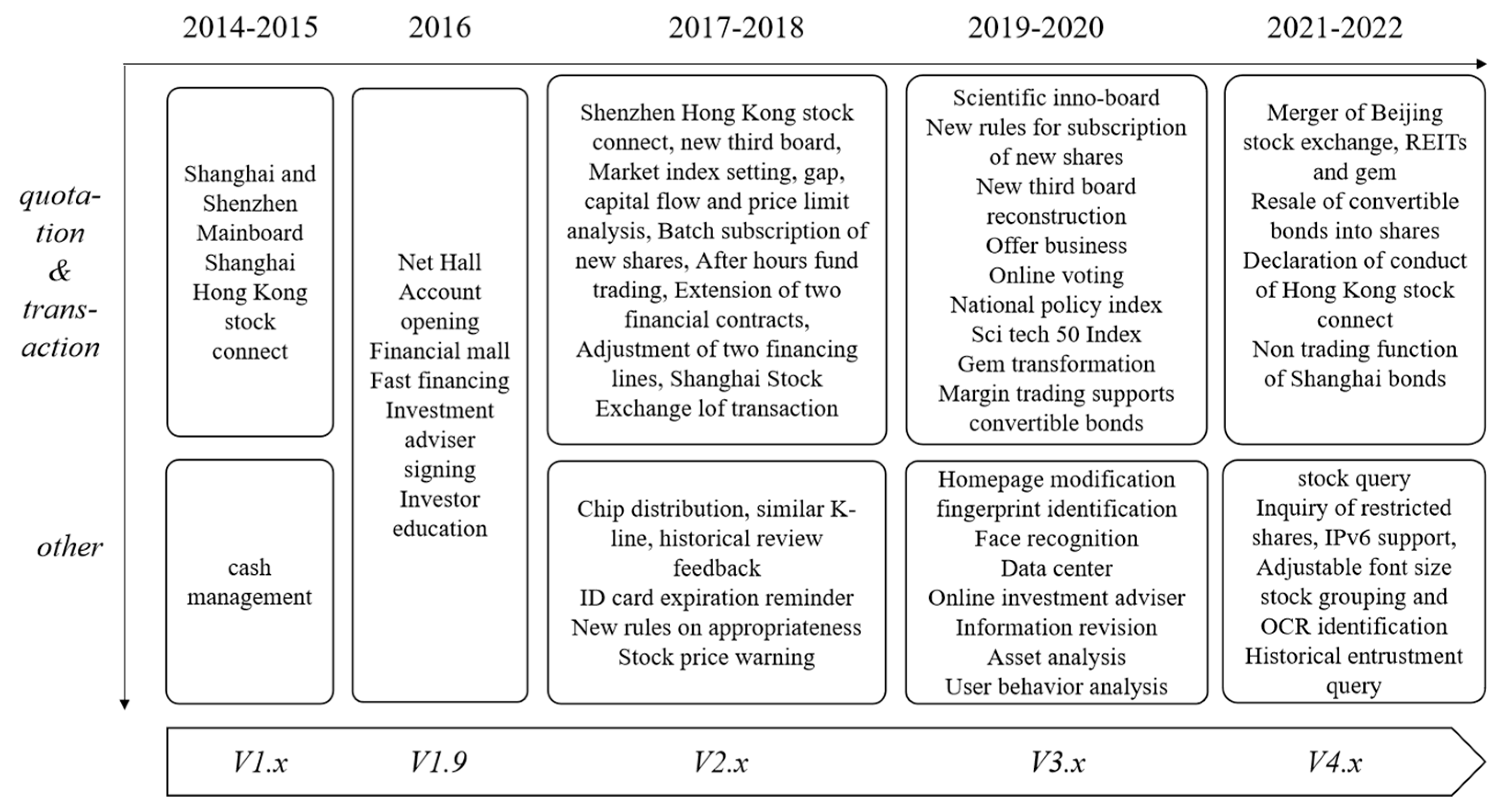
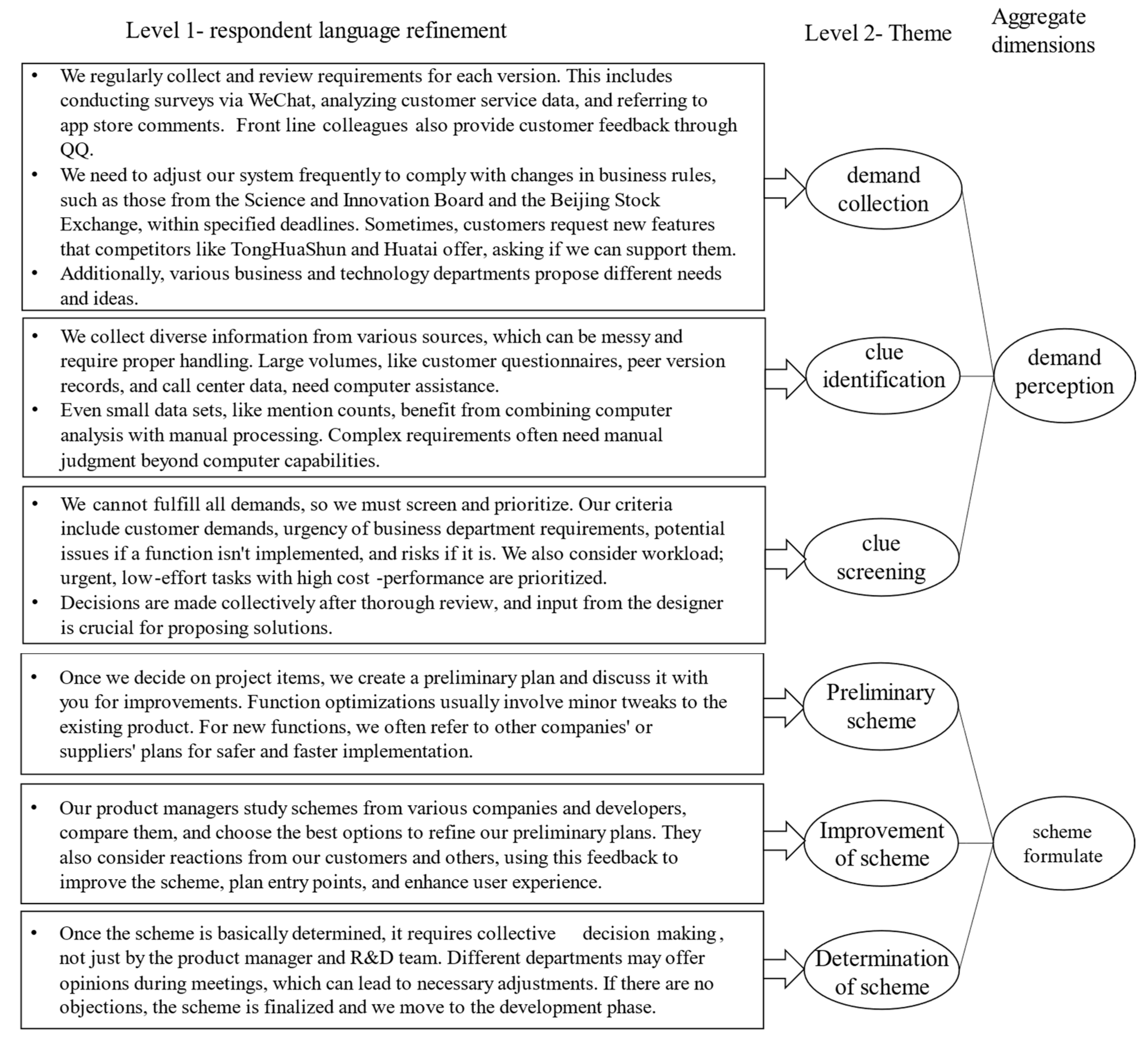
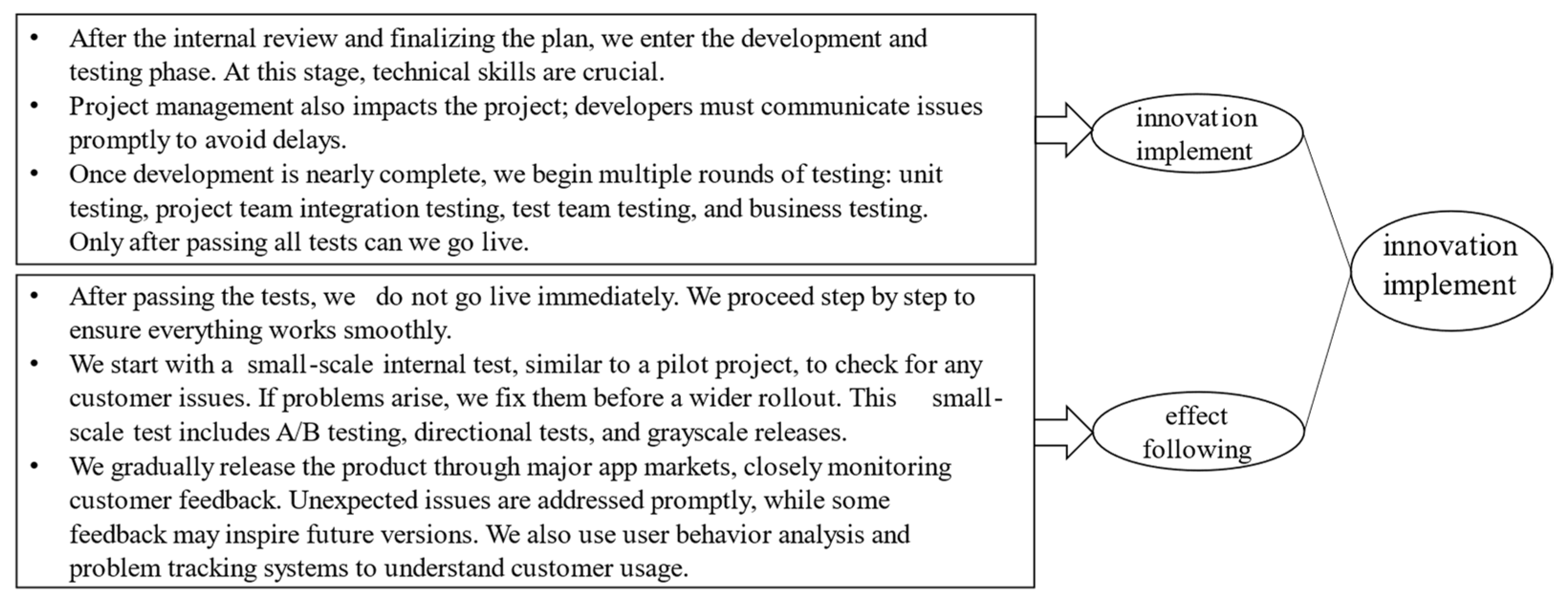
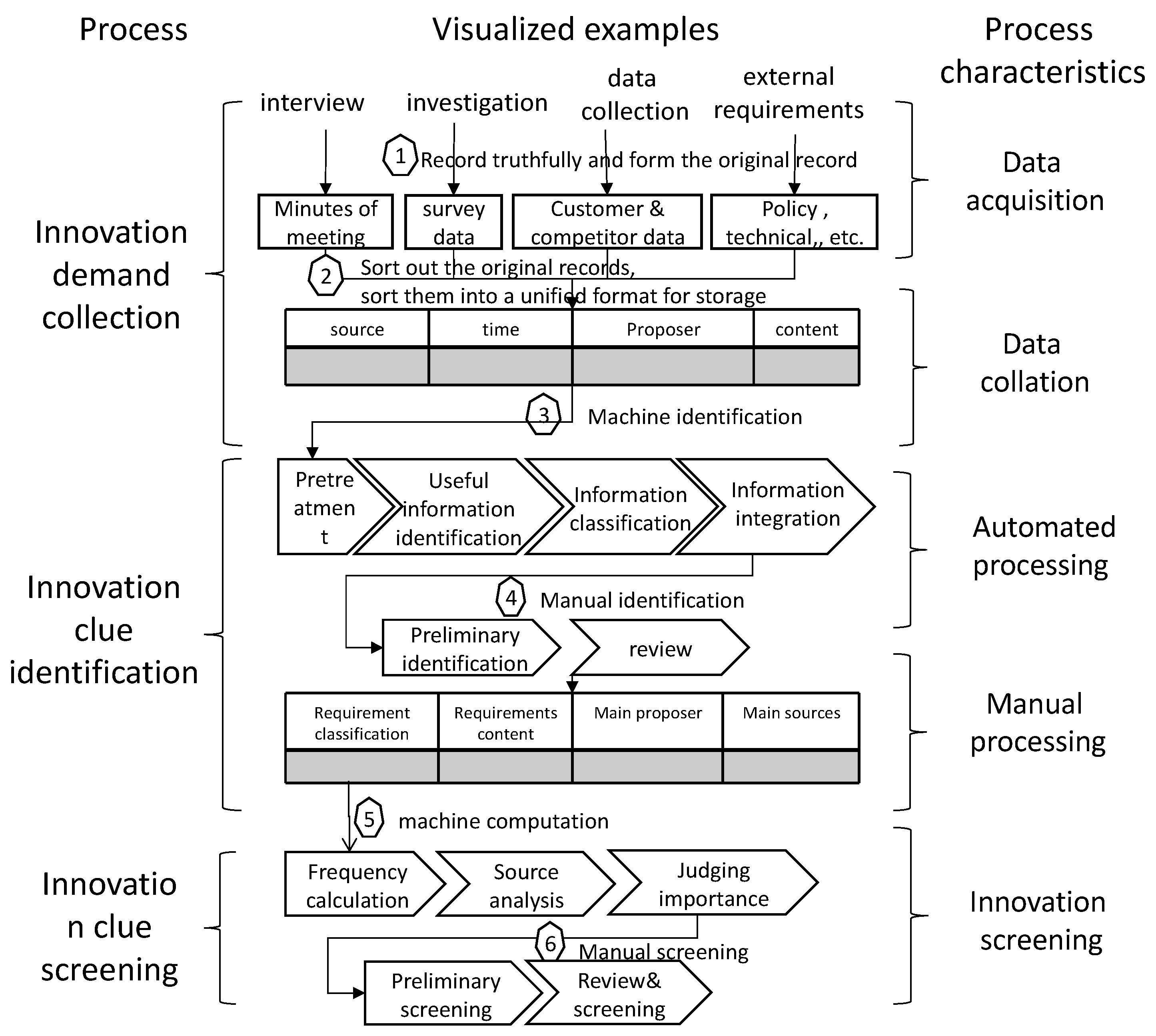
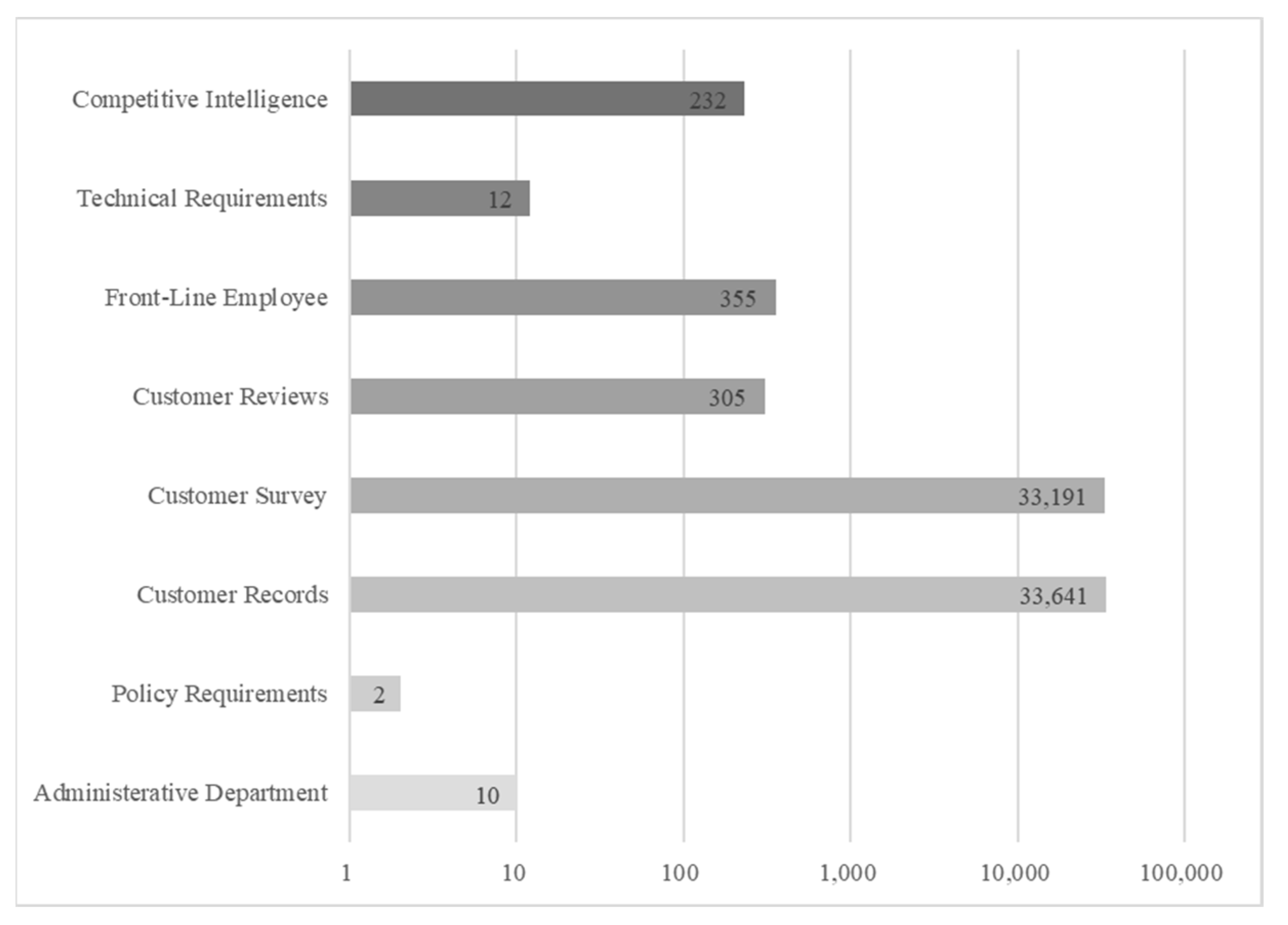
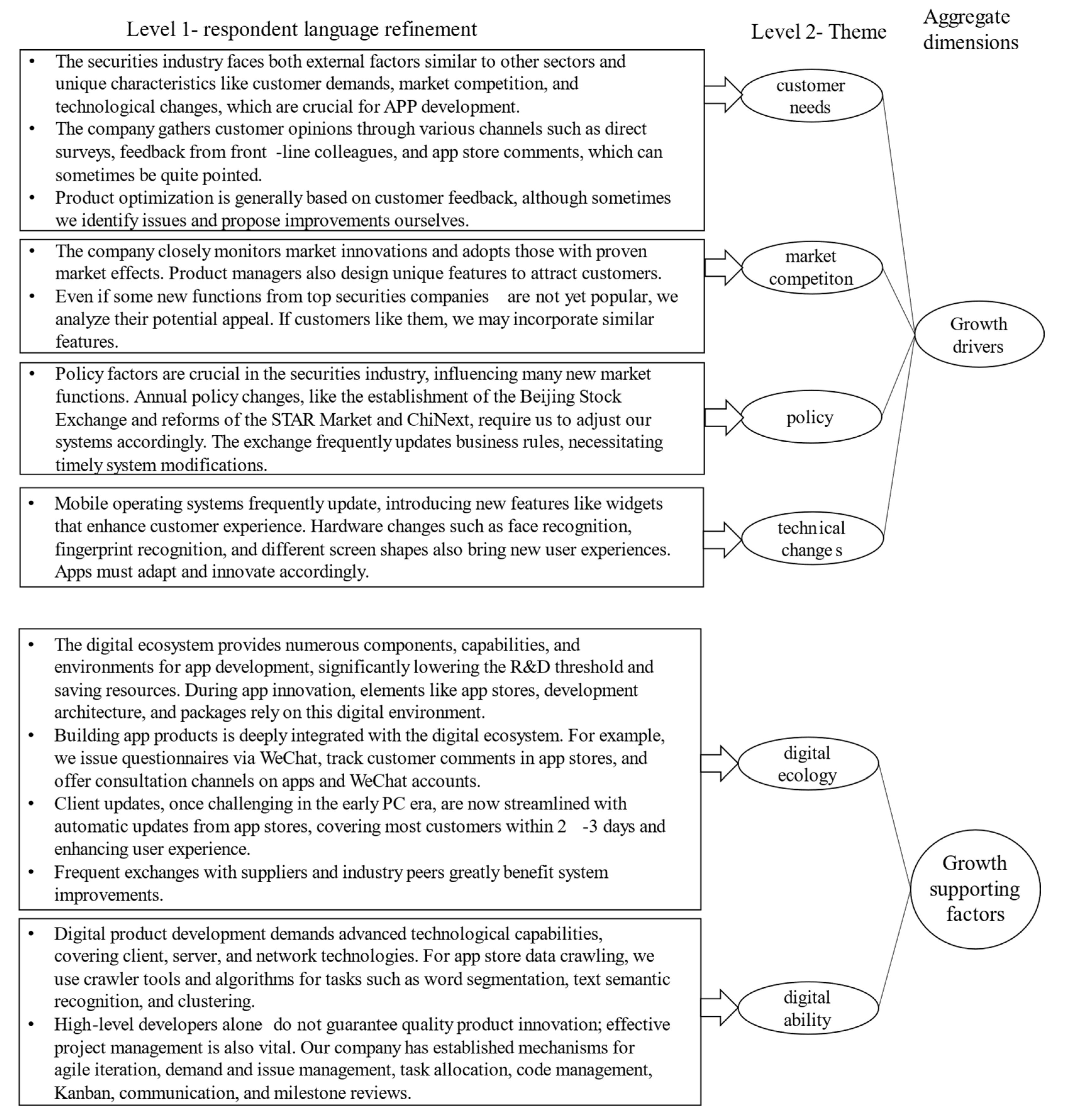
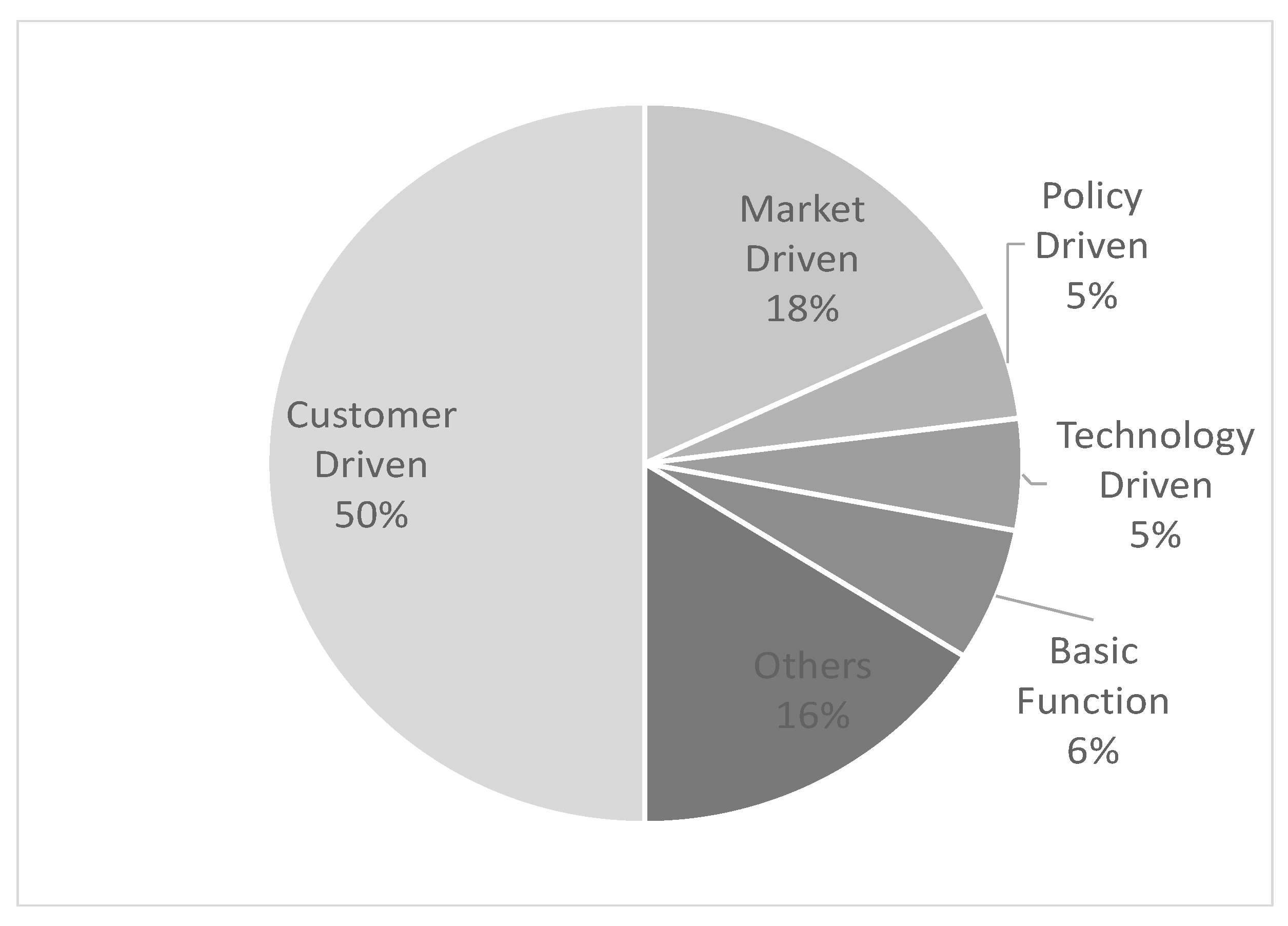
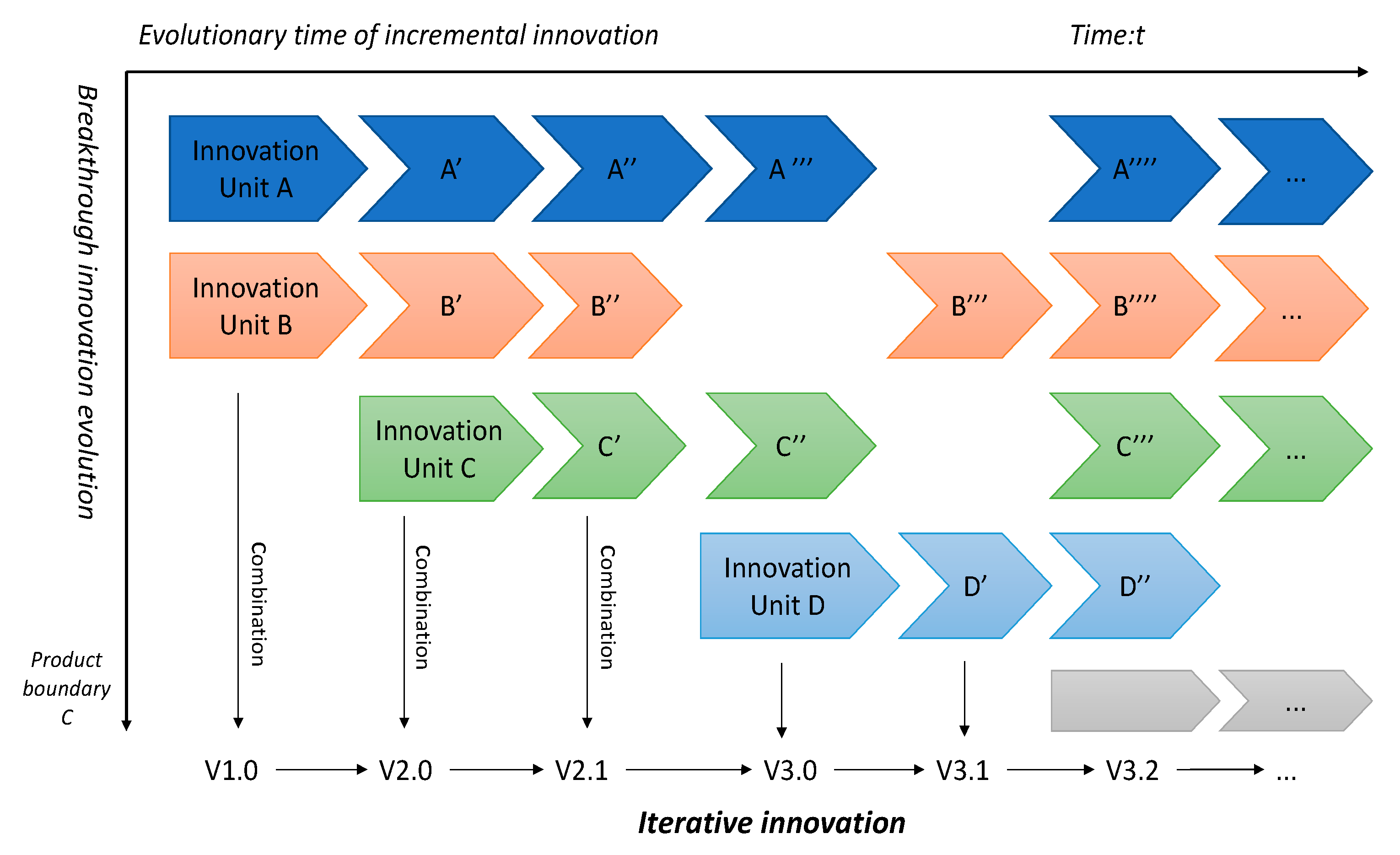
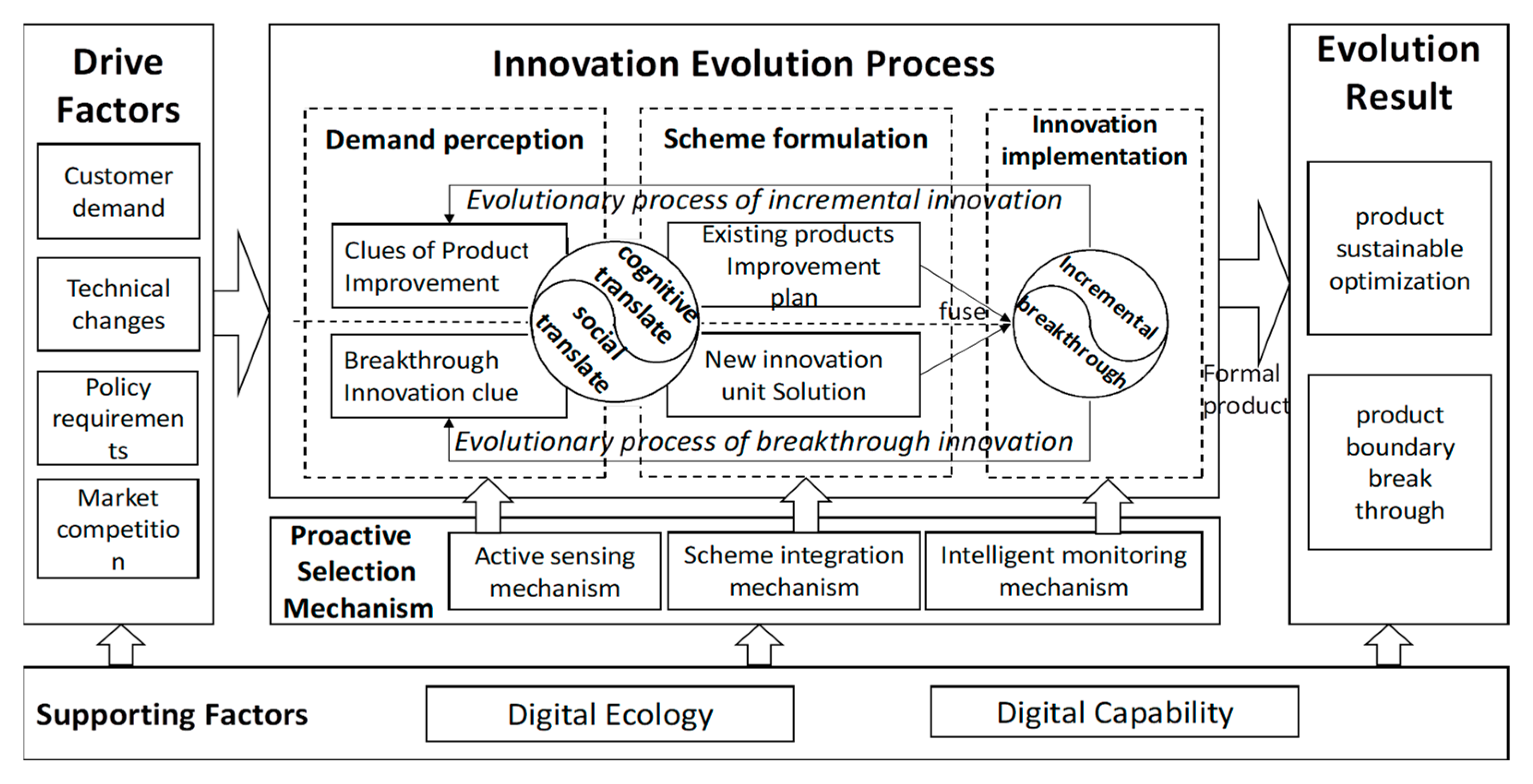
| Research Role | Research Department | Interviewee Position and Personnel | Number of Interviewees | Number of Interviews | Interview Duration | Audio Summary Word Count |
|---|---|---|---|---|---|---|
| Internal Employees of Case Company | Executive | CIO | 1 | 2 | 120 min | 15,000 words |
| Technical | Department Head | 1 | 2 | 70 min | 10,000 words | |
| Technical Department Experts | 2 | 4 | 130 min | 18,000 words | ||
| Business Department | Project Lead | 2 | 4 | 120 min | 16,000 words | |
| External Experts | Senior Researcher at the Institute of Software Research, Chinese Academy of Sciences, and Chairman of a Listed Software Company | 1 | 2 | 60 min | 8000 words | |
| Product Head of China’s Largest Securities Trading Software Company | 1 | 2 | 60 min | 8000 words | ||
| Type of Innovation | Traditional Product Innovation | Digital Product Innovation | |
|---|---|---|---|
| Innovation paradigm | Dichotomy Linear Stage Gate Innovation | Dual-dimensional convergence evolutionary | |
| Incremental innovation | Breakthrough innovation | ||
| Existing product relationships | Based on existing products | Little physical correlation | Innovation based on existing product entrance |
| Degree of innovation | Existing unit upgrade iteration | New innovation unit | Upgrade iteration/add |
| Innovation frequency | Frequently | Longer time | Frequently |
| Process characteristics | Linear discontinuous process | Nonlinear discontinuous process | Nonlinear continuous process |
| Innovation effect | Improvement and optimization of existing products | Expansion of existing product boundaries | Product improvement/boundary expansion |
| Demand interpretation method | Focus on cognitive translation | Focus on social translation | Interactive integration of cognitive and social translation |
| Scheme characteristics | Microenterprise upgrade of existing products | New innovation unit | New innovation/ microenterprise iteration |
Disclaimer/Publisher’s Note: The statements, opinions and data contained in all publications are solely those of the individual author(s) and contributor(s) and not of MDPI and/or the editor(s). MDPI and/or the editor(s) disclaim responsibility for any injury to people or property resulting from any ideas, methods, instructions or products referred to in the content. |
© 2024 by the authors. Licensee MDPI, Basel, Switzerland. This article is an open access article distributed under the terms and conditions of the Creative Commons Attribution (CC BY) license (https://creativecommons.org/licenses/by/4.0/).
Share and Cite
Weng, Z.; Cai, Y.; Weng, S.; Zuo, C. Research on the Sustainable Evolution Mechanism of Dual-Dimensional Convergence Innovation in Digital Products. Sustainability 2024, 16, 7174. https://doi.org/10.3390/su16167174
Weng Z, Cai Y, Weng S, Zuo C. Research on the Sustainable Evolution Mechanism of Dual-Dimensional Convergence Innovation in Digital Products. Sustainability. 2024; 16(16):7174. https://doi.org/10.3390/su16167174
Chicago/Turabian StyleWeng, Zhigang, Yubao Cai, Siqi Weng, and Chun Zuo. 2024. "Research on the Sustainable Evolution Mechanism of Dual-Dimensional Convergence Innovation in Digital Products" Sustainability 16, no. 16: 7174. https://doi.org/10.3390/su16167174
APA StyleWeng, Z., Cai, Y., Weng, S., & Zuo, C. (2024). Research on the Sustainable Evolution Mechanism of Dual-Dimensional Convergence Innovation in Digital Products. Sustainability, 16(16), 7174. https://doi.org/10.3390/su16167174






